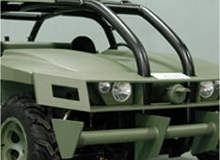
Like the manned ground vehicle platform, the new Aggressor features a hybrid engine with diesel and electric-battery components. Unlike the MGV family, the Aggressor is capable of operating solely on battery power. With its diesel shut down, power generation is extremely quiet and much cooler, which means acoustic and thermal signatures that are difficult to detect even in quiet zones – especially if you’re not looking for them.
Does this make the Aggressor the land equivalent of the B-2 stealth bomber? Yes and no. Hybrid power technology certainly addresses the second part of the hybrid’s better mileage, low visibility mantra, but silent and cool does not add up to undetectable just yet.
A QUICK AND DIRTY GUIDE TO DETECTABILITY
Even from a purely physical perspective, the ways in which surveillance can detect a vehicle span the spectrum. Literally, the radiation spectrum includes visual, infrared (thermal), and microwave (radar) frequencies.
Figuratively, sensors can detect other waveforms such as acoustic or magnetic, or even universal attributes such as the force of gravity (leading to weight, pressure, and mine explosions). Each vehicle has a signature in each modality, and a vehicle’s complete signature set can be highly distinctive if not unique.
Tactically, a more useful categorisation of detection modalities involves the reasons for the signatures rather than the signatures themselves:
Passive emission: when a vehicle is only moving, it produces signatures that hostile sensors can detect passively, i.e. just by ‘listening’. Visual, thermal, acoustic, and pressure / seismic signatures fall into this category, which is the most difficult to eliminate because it is inherent in even minimal operation.
Active reflection: when a vehicle’s composition is different from its background, it is vulnerable to detection by active hostile emissions such as radar (and, in the naval context, sonar). For a variety of reasons, radar is not especially effective in ground-to-ground search, and the advent of aircraft-style stealth materials can make active radar even less useful.
Performance of operations: whenever a vehicle communicates or opens fire, hostile sensors can trace the resulting output back to the source. While techniques such as burst pulses and frequency hopping can make communications tracking more difficult, they can’t eliminate the underlying vulnerability. One of challenges of vehicle design is to find the optimal trade off between functionality and vulnerability.
IT’S THE WAY THAT YOU USE IT
From the above, it should be clear that the thermal and acoustic reductions do not address the entire visibility problem. This is not to say that the entire visibility problem is addressable with current technology, but it does mean that how the Aggressor is deployed will make a difference – and that in some environments the vehicle could be quite vulnerable.
For example, extended all-battery operation is possible only when the Aggressor is using relatively little power. The hard constraint here is energy potential: to get the energy equivalent of 7lb of gasoline, you’d need a half-ton battery. In other words, the Aggressor can operate in silent mode when it is loitering in position, but getting from base to position in all likelihood still requires the diesel.
A related issue is vehicle range, or more precisely, the combination of range and loiter time. Alan Niedzwieki, CEO of Quantum Fuel Systems Technologies, the Aggressor’s developer, bills the Aggressor as ‘a long-range reconnaissance vehicle that fills a technology gap, while reducing its fuel logistic burden’.
A question yet to be definitively answered, however, is exactly what the Aggressor’s range will be under actual operating conditions, and whether ‘long ranges’ will require logistical support meetings that will by nature create their own visibility.
Finally, a critical prerequisite for battery dominance in the propulsion mix is light weight. In other words, the Aggressor will not have the armour or other protection against the landmines and IEDs that have bedevilled Army patrols in Iraq. Conversely, armouring up will erode the distinctive capabilities that make the Aggressor valuable to begin with.
FUTURE DEVELOPMENT NEEDS
The foregoing suggests that the Aggressor’s durability and versatility will benefit from a number of improvements, such as increased battery yield as a function of size, lighter weight materials throughout the frame, and minimisation of power drawdown from the various electronics suites that will doubtless be loaded on to the Aggressor’s field models. For now, the Aggressor is a promising start – but no silver bullet.



